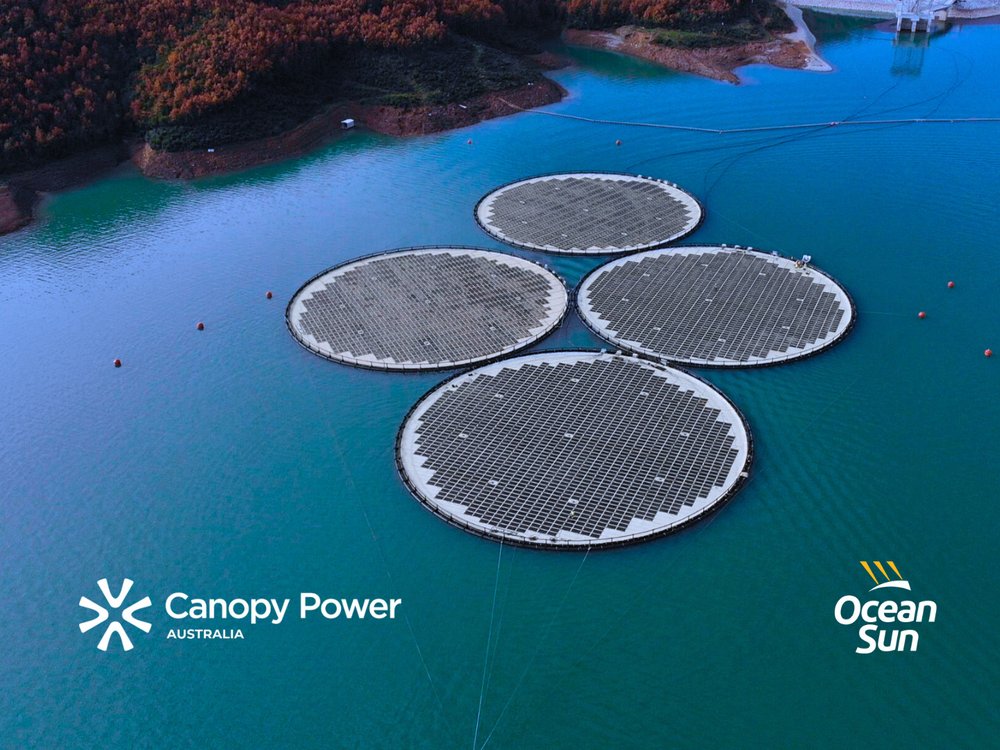
Floating solar PV in Australia has received a boost, as Canopy Power Australia and Ocean Sun, a Norwegian company specialising in floating solar technology, revealed a strategic partnership yesterday (4 February).
Under the terms of the agreement, the two companies will accelerate the deployment of the new generation of floating solar solutions across Australia’s water bodies. This will help provide an additional avenue for solar PV deployment to be scaled.
Try Premium for just $1
- Full premium access for the first month at only $1
- Converts to an annual rate after 30 days unless cancelled
- Cancel anytime during the trial period
Premium Benefits
- Expert industry analysis and interviews
- Digital access to PV Tech Power journal
- Exclusive event discounts
Or get the full Premium subscription right away
Or continue reading this article for free
Ocean Sun will look to deploy a new generation of its floating solar PV technology, which consists of a circular membrane-based floater of 70m diameter, providing 700kWp of generation capacity. The floating power system features solar modules mounted on a polymer membrane, with the technology having been installed at a host of pilot projects in countries such as Albania and the Philippines.
Canopy Power will design and deploy the floating solar microgrid solution and co-locate it when needed with other energy assets, such as battery storage, rooftop or ground-mounted solar PV and wind energy.
Kristian Tørvold, CEO of Ocean Sun, noted the partnership will help introduce the company’s technology to Australia.
“This collaboration leverages our complementary expertise to address critical challenges such as land and water scarcity while accelerating the transition to renewable energy. Together, we aim to provide sustainable and cost-effective solutions that benefit both companies and communities across Australia,” Tørvold said.
Floating solar PV in Australia could help bolster the country’s efforts to decarbonise and shift away from fossil fuels and towards sustainable, renewable energy. Indeed, floating solar PV can ensure that land is used for key infrastructure, such as buildings and farming, as opposed to energy generation.
The technology can also have other environmental benefits. For instance, it can conserve water through reduced evaporation thanks to the membrane coverage on the water body and provide an alternative source of water by harvesting the rainwater collected via integrated pumps situated on the system’s floater. Ocean Suns said these are able to harvest “millions of litres of rainwater per year”.
PV Tech Premium has previously analysed the changing technological profile of floating solar construction, and a recent issue of our downstream journal, PV Tech Power, featured a deep dive into the future of offshore floating solar, from pilot projects to larger scale facilities.
Floating solar PV in Southeast Asia
Southeast Asia has emerged as one of the prime locations for the deployment of floating solar PV.
Early last year, research firm Rystad Energy predicted that Southeast Asia would add around 300MW of new floating solar capacity in the first few months of 2024. This was quickly followed by SolarDuck and Tokyu Land constructing the first floating solar project in Japan.
In August 2024, Malaysian energy company Cypark Resources Berhad commissioned a 100MW hybrid project featuring 35MW of floating solar PV in Merchang, a coastal town in the northeastern state of Terengganu, Malaysia.
Floating solar also emerged as one of the front-running technologies set to be deployed in Indonesia, according to a recent report.
It is also worth noting that India and China have recently seen two large floating solar PV projects come online recently, one of which is at the gigawatt-scale. State-owned China Energy Investment Corporation (CHN Energy) completed a 1GW project, which it claims is the largest and first of its kind in the world.
The open sea floating solar power plant is situated around 8km off the coast of Dongying City, on the eastern coast of China, adjacent to the Bohai Sea.






